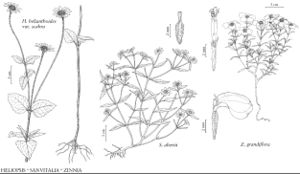Sanvitalia
J. Hist. Nat. 2: 176, plate 33. 1792.
| Taxon | Illustrator ⠉ | |
|---|---|---|
 | Heliopsis helianthoides Sanvitalia abertii Zinnia grandiflora | Marjorie C. Leggitt Bee F. Gunn Yevonn Wilson-Ramsey |
Annuals or perennials, (3–) 10–30 cm. Stems prostrate to erect, branched from bases or ± throughout. Leaves cauline; opposite; petiolate or sessile; blades obovate or spatulate to linear, bases rounded to ± cuneate, margins entire [toothed or lobed], faces hairy. Heads radiate, borne singly. Involucres hemispheric to ± rotate, 4–12+ mm diam. Phyllaries persistent, 8–21 in 2–3 series (lanceolate to linear, outer distally herbaceous, others each with stiff, subulate appendage). Receptacles convex to conic, paleate (paleae conduplicate, scarious). Ray-florets 5–20, pistillate, fertile; corollas white or yellow (laminae sessile, persistent, becoming papery). Disc-florets 15–60, bisexual, fertile; corollas distally yellow to orange (sometimes drying white), tubes much shorter than funnelform throats, lobes 5, deltate. Cypselae ± terete or obscurely 3–4-angled to compressed or flattened (all usually tuberculate and usually bearing uncinate hairs; none, some, or all in each head winged); pappi persistent, of 3–4 awns. x = 8, 11.
Distribution
sw United States, Mexico, Central America, South America
Discussion
Species 5 (3 in the flora).
Selected References
Lower Taxa
Key
| 1 | Phyllaries 8–11; ray cypselae subterete, obscurely 3-angled, sulcate on each angle and on abaxial faces | Sanvitalia abertii |
| 1 | Phyllaries 12–21; ray cypselae 3-angled (clearly 3-faced, adaxial faces often 2–3-nerved) | > 2 |
| 2 | Disc cypselae strongly dimorphic within heads: outer wingless, inner 1–2-winged | Sanvitalia procumbens |
| 2 | Disc cypselae ± monomorphic within heads, ± 4-angled to laterally compressed, none winged | Sanvitalia ocymoides |
"broader" is not a number.